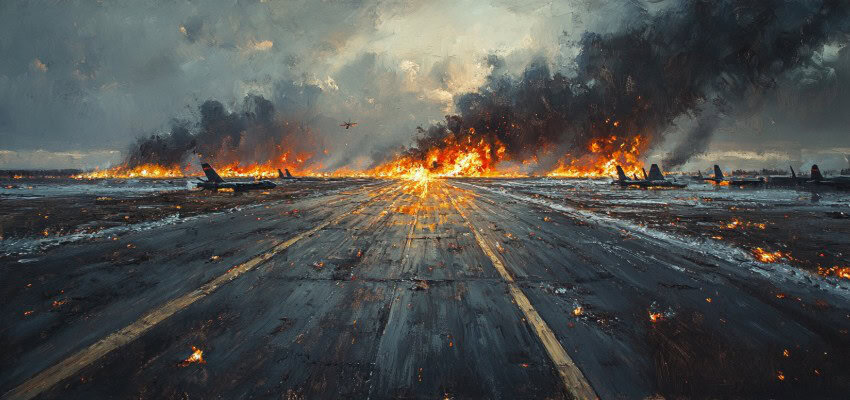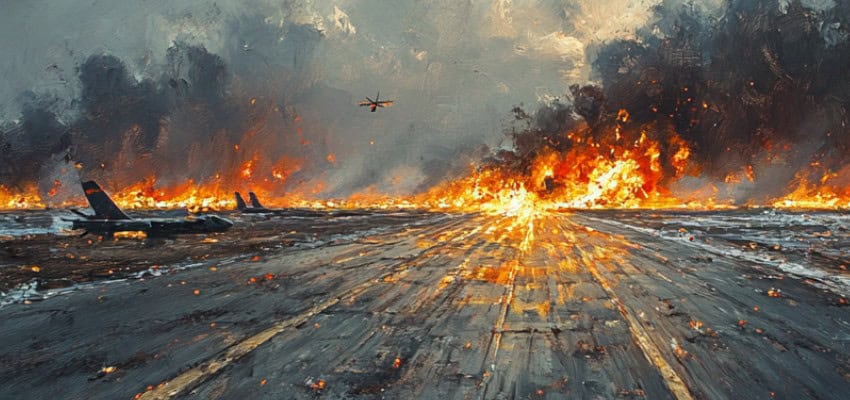Editor’s Note: This narrative summary of the Institute for the Study of War’s June 1, 2025, campaign update captures a significant escalation in Ukraine’s use of asymmetric warfare—specifically, its unprecedented drone strike campaign deep inside Russian territory. It reflects Ukraine’s shifting strategy from defensive resilience to strategic offensive disruption, revealing new vulnerabilities within the Russian military’s rear-area infrastructure. Framed for a defense and intelligence-oriented readership, this report highlights the operational innovations, systemic failures, and geopolitical implications stemming from this event, with an emphasis on verifiable developments. As always, this analysis refrains from speculation, instead providing a fact-based account with contextual rigor befitting professionals monitoring the conflict’s evolving character.
For those seeking to grasp the full scope of this evolving landscape, the complete updates from the Institute for the Study of War serve as an invaluable resource.
Content Assessment: Deep Strike: Ukraine’s Drone Offensive Shakes Russia’s Strategic Core
Information - 94%
Insight - 95%
Relevance - 93%
Objectivity - 94%
Authority - 95%
94%
Excellent
A short percentage-based assessment of the qualitative benefit expressed as a percentage of positive reception of the recent article from ComplexDiscovery OÜ titled, "Deep Strike: Ukraine’s Drone Offensive Shakes Russia’s Strategic Core]."
Background Note: ComplexDiscovery’s staff offers distinctive perspectives on the Russo-Ukrainian war and Middle Eastern conflicts, informed by military experience on the West German, East German, and Czechoslovakian border during the Cold War and in Sinai as part of Camp David Accord compliance activities. This firsthand regional knowledge has been further enhanced by recent staff travels to Eastern European countries, including Estonia, Finland, Latvia, Lithuania, and Poland. These visits have provided up-to-date, on-the-ground insights into the current geopolitical climate in regions directly impacted by the ongoing conflict.
Combined with cybersecurity, information governance, and eDiscovery proficiency, this multifaceted experience enables comprehensive analysis of these conflicts, including the critical impact of cyber warfare, disinformation, and digital forensics on modern military engagements. This unique background positions ComplexDiscovery to provide valuable insights for conflict-related investigations and litigation, where understanding the interplay of technology, data, and geopolitical factors is crucial.
Russo-Ukrainian Conflict Update*
Deep Strike: Ukraine’s Drone Offensive Shakes Russia’s Strategic Core
ComplexDiscovery Staff
On June 1, 2025, Ukraine delivered a transformative blow to Russian strategic aviation infrastructure through an audacious and meticulously coordinated drone offensive targeting four Russian air bases. This unprecedented operation, executed by the Security Service of Ukraine (SBU), leveraged first-person view (FPV) drones launched from within Russian territory, striking key military sites at Belaya (Irkutsk), Olenya (Murmansk), Dyagilevo (Ryazan), and Ivanovo (Ivanovo Oblast). President Volodymyr Zelensky confirmed the scale and success of the operation, citing the use of 117 drones and claiming destruction of 34 percent of Russia’s cruise missile-carrying aircraft, notably Tu-95 and Tu-22M3 bombers, as well as A-50 airborne radar aircraft.
The method of attack employed by Ukraine—concealing drones in semi-trailer trucks near the air bases and launching them via retractable roofs—enabled a rare element of strategic surprise. By deploying the drones from close proximity, Ukrainian operators bypassed Russian electronic warfare defenses and ensured deep penetration into Russian rear areas. This operation also marked the first Ukrainian strike on a target within Siberia, symbolizing a considerable escalation in reach and impact.
Beyond its tactical success, the operation introduced significant operational and strategic ramifications for Russia. The targeted bombers are critical components of Russia’s long-range strike capabilities, regularly used to deploy Kh-101/555 and Kh-59/69 cruise missiles. Damaging or destroying them not only depletes a limited inventory—estimated at fewer than 90 strategic bombers—but also challenges Russia’s ability to maintain its offensive missile campaign. With A-50 aircraft costing an estimated $500 million each and irreplaceable due to production constraints, Russia faces a protracted and costly recovery.
Predictably, the drone strikes ignited internal recriminations within the Russian military and political establishment. Prominent milbloggers and State Duma members lambasted Russian leadership for its inability to safeguard critical infrastructure. Criticism was particularly focused on the apparent lack of adaptation to the evolving threat landscape, including continued reliance on open-air storage for strategic assets. These failures, recurring throughout the war, reflect systemic command shortcomings and an overconfidence in geographic distance from the Ukrainian border.
Concurrently, Russia’s propagandists and some military analysts responded with nuclear saber-rattling, framing the strikes as an existential threat justifying nuclear escalation under Russia’s revised doctrine. However, analysts at the Institute for the Study of War (ISW) maintain that such rhetoric is primarily designed to deter Western aid and does not indicate an imminent change in Russia’s nuclear posture.
Adding to the volatility, Russia accused Ukraine of sabotaging railway infrastructure in Bryansk and Kursk Oblasts—accusations lacking evidence but seemingly crafted to justify the initiation of new Russian offensive operations in Sumy Oblast. The collapse of two railway bridges and subsequent derailments were used to reframe Ukraine as a destabilizing actor and bolster Kremlin narratives against peace negotiations.
Simultaneously, Russia escalated its own aerial campaign, launching its largest-ever combined missile and drone attack against Ukraine overnight from May 31 to June 1. The barrage included over 470 drones, supported by ballistic and cruise missiles. While Ukrainian air defenses intercepted a significant portion—213 drones and several cruise missiles—they failed to neutralize any of the ballistic missiles, highlighting the limitations of Ukraine’s Patriot missile defense coverage and the growing sophistication of Russian strike systems.
These developments unfolded against a backdrop of internal accountability in Ukraine. Ground Forces Commander Mykhailo Drapatyi tendered his resignation following a deadly Russian missile strike on a Ukrainian training unit in Dnipropetrovsk Oblast. Drapatyi’s resignation underscored a principled leadership response to systemic flaws and reflected broader cultural efforts within the Ukrainian military to instill responsibility at senior levels.
Despite these high-stakes escalations, diplomatic maneuvering continued. President Zelensky authorized a formal Ukrainian delegation to participate in the upcoming July 2 peace talks in Istanbul. The delegation includes high-ranking officials across Ukraine’s military and intelligence sectors. However, Russian negotiators have yet to present any concrete proposals, and recent military actions suggest a continued preference for battlefield gains over diplomatic resolution.
On the battlefield, Russian ground operations persisted without significant progress in most areas. Notable exceptions included modest advances in the Toretsk direction and near Sumy City, where Russian forces have reportedly come within artillery range. These actions reflect Russia’s broader strategy to establish buffer zones and prolong hostilities, contradicting narratives suggesting a limited territorial agenda. Across other fronts—from Kupyansk to Kherson—Russian forces launched multiple offensive efforts but made no verifiable territorial gains.
The June 1 assessment underscores a pivotal moment in the conflict, where Ukrainian innovation and strategic boldness have challenged longstanding assumptions about reach, deterrence, and escalation thresholds. As Ukraine redefines the contours of the operational environment, the Kremlin is left grappling with both the immediate impact of its losses and the longer-term implications for its military credibility.
Looking ahead, one must ask: how will Russia adapt to an adversary capable of striking deep within its heartland, and can Ukraine sustain the technological and operational edge that now shapes the tempo of the war?
Detailed Reporting with Maps for June 1, 2025, from the ISW – Mouseover to Scroll
Russo-Ukrainian War June 01 2025-UpdateReview the Detailed Reporting and Maps PDF
About the Institute for the Study of War Research Methodology
ISW’s research methodology relies on both primary and secondary sources, enabling researchers to develop a comprehensive understanding of the situation on the ground. In order to analyze military and political developments in any given area, ISW’s research analysts must wholly understand the systems of enemy and friendly forces. They must also understand the population demographics, physical terrain, politics, and history of that area. This lays the analytical foundation for understanding the reasons for particular developments and fulfilling their assigned research objectives. ISW analysts also spend time in places like Iraq, Afghanistan, and elsewhere in order to gain a better understanding of the security and political situation and to evaluate the implementation of current strategies and policies. Their researchers compile data and analyze trends, producing a granular analysis of developments in areas of research, producing an accurate, high-resolution, timely, and thorough picture of the situation. ISW’s research methodology guarantees its success and commitment to improving the nation’s ability to execute military operations, achieve strategic objectives, and respond to emerging problems that may require the use of American military power.
About the Institute for the Study of War
The Institute for the Study of War advances an informed understanding of military affairs through reliable research, trusted analysis, and innovative education. They are committed to improving the nation’s ability to execute military operations and respond to emerging threats in order to achieve U.S. strategic objectives. ISW is a non-partisan, non-profit, public policy research organization.
Learn more, get involved, and contribute today.
Assisted by GAI and LLM Technologies
* Sourced and shared with direct expressed permission from the Institute for the Study of War (ISW).
Additional Reading
- From Dissent to OSINT? Understanding, Influencing, and Protecting Roles, Reputation, and Revenue
- Data Embassies: Sovereignty, Security, and Continuity for Nation-States
Source: ComplexDiscovery OÜ



























